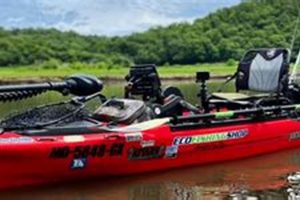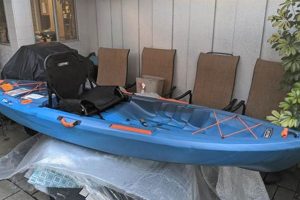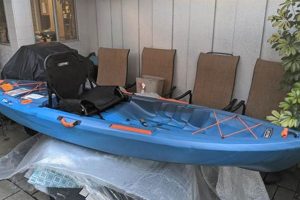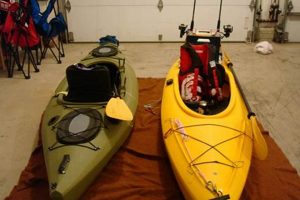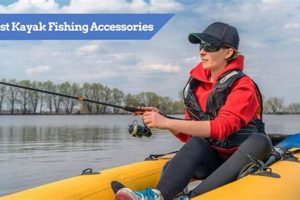Creating custom gear for angling kayaks enhances the fishing experience by offering tailored solutions to specific needs and preferences at a potentially lower cost. Examples include rod holders fashioned from PVC pipe, tackle storage systems built from repurposed containers, and anchor trolleys crafted with readily available hardware. These personalized adaptations optimize kayak layout and functionality for individual anglers.
The ability to personalize a fishing kayak through handcrafted modifications offers significant advantages. Customization allows anglers to address specific needs not met by commercially available products. This can range from specialized storage for particular lures to unique mounting solutions for electronics. Cost savings represent another compelling benefit, as many do-it-yourself projects utilize readily available, inexpensive materials. Furthermore, this hands-on approach fosters a deeper understanding of the kayak’s setup and encourages ingenuity in tackling challenges encountered on the water. Historically, anglers have always adapted their equipment, and the DIY ethos thrives in the kayak fishing community due to the sport’s emphasis on efficiency and personalization.
This exploration will delve into various aspects of creating customized kayak fishing equipment, including popular project ideas, essential tools and materials, safety considerations, and resources for inspiration and guidance.
Tips for DIY Kayak Fishing Accessories
Careful planning and execution are crucial for successful do-it-yourself kayak fishing accessory projects. The following tips offer guidance for creating functional and durable enhancements.
Tip 1: Prioritize Stability and Safety: Any modification should not compromise the kayak’s stability. Added weight should be distributed evenly and securely. Sharp edges or protrusions must be avoided to prevent injury. Test all modifications in calm water before venturing into more challenging conditions.
Tip 2: Select Appropriate Materials: Marine-grade materials resist corrosion and withstand the harsh marine environment. UV-resistant components retain strength and appearance over time. Consider weight and durability when choosing materials for specific projects.
Tip 3: Plan Thoroughly Before Construction: Detailed sketches and measurements ensure proper fit and function. Consider ergonomics and accessibility when determining placement of accessories. A well-defined plan minimizes errors and rework.
Tip 4: Utilize Proper Tools and Techniques: Employ appropriate tools for cutting, drilling, and fastening materials. Follow established best practices for working with different materials, such as plastics, metals, and adhesives. Accurate measurements and secure fastenings are essential for durability and safety.
Tip 5: Test and Refine Designs: Initial testing often reveals areas for improvement. Modifications may be necessary to optimize functionality and address unforeseen issues. Iterative refinement leads to more effective and user-friendly designs.
Tip 6: Research Existing Designs for Inspiration: Numerous online resources and forums offer inspiration and guidance. Examining existing designs can spark new ideas and provide valuable insights into construction techniques and material selection.
Tip 7: Consider Modularity and Adaptability: Design accessories for easy removal or adjustment. This allows for customization based on changing needs and fishing conditions. Modular designs offer greater flexibility and long-term utility.
By adhering to these guidelines, anglers can create effective and durable custom accessories that enhance their kayak fishing experience while ensuring safety and functionality.
These tips provide a foundation for successful DIY kayak fishing accessory projects. The next section will explore specific project ideas and resources for further exploration.
1. Customization
Customization represents a core principle within the practice of crafting do-it-yourself fishing kayak accessories. It allows anglers to tailor their vessels to individual fishing styles, target species, and body ergonomics, optimizing both comfort and effectiveness on the water.
- Rod Holder Placement and Type
Anglers frequently customize rod holder placement and type to accommodate specific fishing techniques. A fly fisherman might prioritize easily accessible horizontal rod holders, while a troller might prefer angled rod holders positioned for optimal line retrieval. DIY solutions allow for precise placement and selection of specialized holders unavailable commercially, enhancing both efficiency and technique-specific performance.
- Tackle Storage Solutions
Storage solutions are often personalized to organize lures and tackle based on individual preferences and frequently used equipment. Customized tackle trays, boxes, and compartments within the kayak ensure readily accessible gear, minimizing wasted time searching and maximizing fishing efficiency. These solutions can be tailored to specific lure types and sizes, optimizing organization and space utilization within the kayak.
- Electronic Mounts and Wiring
Integrating fish finders, GPS units, and other electronics requires customized mounts and wiring solutions tailored to the specific kayak and equipment. DIY approaches allow anglers to position electronics for optimal visibility and ergonomics while concealing wiring for a clean and functional setup. This level of control enhances usability and minimizes clutter, promoting a more focused and enjoyable fishing experience.
- Comfort and Ergonomic Adaptations
Customization extends to comfort enhancements, such as modified seating, footrests, and backrests. These adjustments, often tailored to individual body types and preferences, can significantly improve comfort during long hours on the water. DIY solutions allow anglers to address specific ergonomic needs not met by standard kayak configurations, promoting sustained comfort and preventing fatigue.
These facets of customization highlight the inherent link between do-it-yourself accessories and a truly personalized kayak fishing experience. By tailoring their vessels to individual needs and preferences, anglers enhance not only the functionality of their kayaks but also their overall enjoyment and success on the water.
2. Cost-effectiveness
Cost-effectiveness represents a significant driver behind the creation of do-it-yourself fishing kayak accessories. Commercial products designed for kayak angling often carry premium prices. The DIY approach allows anglers to achieve comparable functionality at a fraction of the cost, utilizing readily available materials and repurposed items.
- Repurposing Existing Materials
Repurposing existing materials significantly reduces expenses. Household items like milk crates, PVC pipe, and bungee cords can be transformed into functional kayak accessories. This resourceful approach minimizes waste and demonstrates that effective solutions do not necessitate expensive, specialized products.
- Material Selection and Sourcing
Careful selection and sourcing of materials contribute to cost savings. Comparing prices across different suppliers, opting for readily available alternatives, and purchasing materials in bulk can significantly lower overall expenses. Resourcefulness in material acquisition contributes substantially to the economic advantages of DIY projects.
- Reduced Reliance on Commercial Products
DIY projects lessen reliance on commercially manufactured accessories, many of which incur significant markups. Building essential items like rod holders, anchor trolleys, and paddle leashes allows anglers to allocate their budget towards other essential fishing gear or experiences, maximizing overall value.
- Long-Term Cost Savings through Durability and Repair
While initial material costs represent one aspect of cost-effectiveness, the long-term savings achieved through durability and repairability are equally important. Well-constructed DIY accessories, often built with robust materials, can withstand considerable wear and tear, reducing the need for frequent replacements. Furthermore, the ability to repair DIY accessories rather than replace them contributes to ongoing cost savings over the lifespan of the equipment.
The cost-effectiveness inherent in the DIY approach empowers anglers to equip their kayaks effectively without incurring substantial financial burdens. This focus on resourcefulness and affordability aligns seamlessly with the broader ethos of kayak fishing, which emphasizes efficiency and a close connection with the natural environment.
3. Practicality
Practicality forms the cornerstone of effective do-it-yourself fishing kayak accessories. Modifications must enhance, not hinder, the angling experience. A poorly designed rod holder that obstructs paddling or a tackle storage system prone to tipping compromises functionality and detracts from the overall fishing experience. Practicality dictates that each modification serves a clear purpose, improves efficiency, and integrates seamlessly with the kayak’s existing features and the angler’s workflow. For example, a well-placed anchor trolley system allows for efficient boat control in various current conditions, directly impacting fishing success.
Practical considerations influence every stage of the design and construction process. Material selection must balance durability with weight and functionality. Placement of accessories requires careful consideration of ergonomics, accessibility, and impact on stability. Overly complex or cumbersome designs, while potentially visually appealing, often sacrifice practicality on the water. A simple, robust, and easily accessible DIY paddle leash, for instance, provides greater practical value than an elaborate but less functional design. The core principle lies in optimizing utility and effectiveness within the constraints of the kayak environment.
Ultimately, practicality dictates the true value of any DIY kayak fishing accessory. Aesthetics and innovative design hold secondary importance to functionality and user-friendliness. The objective centers on enhancing the fishing experience through thoughtful modifications that address genuine needs and streamline on-the-water activities. Challenges arise when practicality is overlooked in favor of complexity or aesthetics. Focusing on essential functionality and user-centered design ensures that DIY projects contribute positively to angling success and enjoyment.
4. Durability
Durability stands as a critical factor in the effectiveness of do-it-yourself fishing kayak accessories. The marine environment presents harsh conditions, including exposure to saltwater, UV radiation, and physical stress. Accessories lacking durability necessitate frequent repairs or replacements, negating the cost and time-saving benefits of DIY projects. A durable fish finder mount, for example, ensures consistent performance of essential electronics, while a flimsy mount risks failure and potential loss of equipment. Material selection directly impacts durability; marine-grade stainless steel fasteners and UV-resistant plastics offer superior longevity compared to less robust alternatives.
Constructing durable accessories requires attention to detail throughout the fabrication process. Proper sealing of wooden components prevents water damage and rot. Reinforcing high-stress areas, such as rod holder mounts and anchor trolley attachment points, minimizes the risk of failure under load. Employing appropriate fastening techniques, including the use of marine-grade adhesives and sealants, further enhances overall durability. A well-constructed DIY tackle storage system, built with durable materials and robust joinery, provides reliable service over extended periods, outlasting less robustly constructed alternatives.
Understanding the interplay between material selection, construction techniques, and environmental factors allows for the creation of fishing kayak accessories that withstand the rigors of regular use. Durability translates to long-term cost savings, reduced maintenance, and enhanced reliability on the water. Challenges arise when durability is compromised for aesthetics or expediency. Prioritizing robust construction and material selection ensures that DIY accessories contribute positively to the overall kayak fishing experience, providing reliable performance and extended service life.
5. Safety
Safety represents a paramount concern in the design, construction, and use of do-it-yourself fishing kayak accessories. Modifications must not compromise the kayak’s inherent stability or introduce potential hazards. Improperly installed rod holders, for example, can create snag points, increasing the risk of capsizing. Similarly, poorly secured gear adds weight, potentially affecting the kayak’s balance and maneuverability. An improperly designed anchor trolley system can create entanglement hazards, posing a serious risk in moving water. Understanding and mitigating potential safety risks is essential for responsible DIY kayak modification.
Careful consideration of stability, weight distribution, and potential entanglement hazards is crucial throughout the DIY process. Accessories should be positioned to minimize interference with paddling and other essential kayak operations. Sharp edges or protrusions must be avoided to reduce the risk of injury during use. All additions should be securely fastened using appropriate marine-grade hardware to prevent detachment and potential loss of equipment or creation of hazardous debris in the water. Testing modifications in calm, controlled environments before venturing into open water allows for identification and correction of potential safety issues before they pose a risk in more challenging conditions. A DIY rudder system, while potentially beneficial for maneuverability, must be carefully designed and installed to avoid interference with the kayak’s inherent stability and control.
Prioritizing safety ensures that DIY modifications enhance, rather than detract from, the overall kayak fishing experience. A thorough risk assessment should precede any modification, considering potential impacts on stability, maneuverability, and entanglement hazards. Careful material selection, robust construction techniques, and thorough testing contribute to safer and more reliable DIY accessories. Neglecting safety considerations can lead to equipment failure, personal injury, or even capsizing, undermining the enjoyment and purpose of kayak fishing. Integrating safety considerations into every stage of the design and construction process ensures that DIY projects contribute positively to a secure and enjoyable on-the-water experience.
Frequently Asked Questions
This section addresses common inquiries regarding the creation and utilization of do-it-yourself fishing kayak accessories.
Question 1: What are the most popular DIY fishing kayak accessories?
Popular projects include rod holders, paddle leashes, anchor trolleys, tackle storage systems, and mounting solutions for fish finders and other electronics. These modifications offer significant improvements to functionality and personalization.
Question 2: What materials are commonly used in DIY kayak fishing accessories?
Commonly used materials include PVC pipe, marine-grade plywood, stainless steel hardware, nylon webbing, and various plastics. Material selection depends on the specific project and desired durability.
Question 3: How can stability be maintained when adding DIY accessories?
Maintaining stability requires careful consideration of weight distribution. Accessories should be positioned to minimize impact on the kayak’s center of gravity. Keeping additions lightweight and evenly distributed helps prevent instability.
Question 4: Are there safety concerns specific to DIY kayak modifications?
Safety concerns include potential compromises to stability, creation of snag points, and improper installation of accessories. Thorough testing and careful construction are crucial for mitigating these risks. Adhering to established safety guidelines is paramount.
Question 5: Where can one find inspiration and guidance for DIY kayak projects?
Online forums, kayak fishing communities, and video tutorials offer valuable resources and inspiration. Sharing knowledge and experiences within these communities fosters innovation and safe practices.
Question 6: How can one ensure the durability of DIY kayak accessories?
Durability depends on appropriate material selection and construction techniques. Utilizing marine-grade materials, proper sealing, and robust fastening methods contribute to long-lasting performance in harsh marine environments.
Careful planning, appropriate material selection, and thorough testing are crucial for successful DIY kayak fishing accessory projects. Prioritizing safety and functionality ensures modifications enhance the fishing experience.
This FAQ section has provided answers to common inquiries. The following section will offer concluding thoughts on DIY kayak fishing accessories and their benefits.
Conclusion
Crafting fishing kayak accessories presents opportunities for enhanced functionality, personalized design, and cost savings. Careful consideration of materials, construction techniques, stability, and safety is essential for successful project outcomes. Durability and practicality remain paramount for long-term effectiveness and enjoyment on the water. The exploration of customization options, from rod holder placement to tackle storage solutions, highlights the potential for tailoring kayaks to individual angling styles and preferences. Ultimately, the thoughtful integration of DIY accessories can significantly enrich the kayak fishing experience.
The convergence of ingenuity and practicality within the realm of fishing kayak accessories empowers anglers to optimize their vessels for specific needs and preferences. This pursuit of enhanced functionality and personalized design fosters a deeper connection between angler and kayak, ultimately contributing to a more rewarding and efficient experience on the water. The potential for continuous refinement and adaptation ensures that the evolution of DIY kayak accessories will continue to shape the future of this dynamic and evolving sport.


